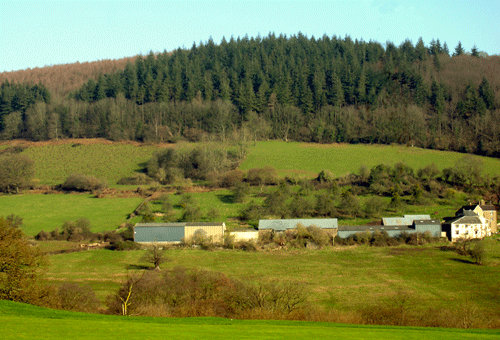Lower Wye Valley
023 Hayes Coppice

HLCA 023 Hayes Coppice
Ancient Woodland with irregular enclosures associated with Newton Court: mixed parkland planting; industrial archaeology: quarrying; communication and boundaries (estate walls) and boundary features; relict Archaeology: potential for woodland management features. Back to map
Historic Background
The historic landscape area of Hayes Coppice occupies the south end of a low ridge running along the west bank of the River Wye. Its boundaries are defined by the extent of the ancient woodland to the south, east and west, and by the national border to the north. The area lies in the parish of Dixton, in the manor of Newton.
The area, which now contains a mixture of conifer plantation and broad-leafed woodland, has existed as woodland at least since the date of the tithe map (1845), which lists the state of cultivation for the majority of the areas as 'woods'. Most of the area comprises replanted ancient woodland, though a narrow strip of woodland on the lower slopes to the northeast of the area survives as ancient semi-natural woodland.
The tithe map shows a number of enclosures around the edges of the area, the majority of which are listed as being under woodland, although some small areas are listed as arable. These enclosures still exist to some extent by the survey the First Edition OS maps (1881), but have largely been omitted from recent mapping (OS 2006 1:10000 Landline data). The apportionment, which accompanies the tithe map, lists the main landowner as Mary Griffin; the area was part of the estate purchased from Lord Gage by Admiral Griffin; the Griffin family was responsible for the construction of Newton Court in the adjoining area (HLCA021) (Bradney 1904).
The northern border of this area has particular historical significance as it forms the national boundary between England and Wales; two boundary stones mark the boundary in the area. Further post-medieval activity can is represented by extractive features, and by an Ordnance Survey triangulation pillar (PRN 07463g).
Historic Landscape Characteristics
Hayes Coppice is characterised by ancient woodland, mixed woodland, though predominantly coniferous plantation, which occupies the steep valley sides and summit of the ridge which forms the west side of the Wye Valley. A narrow area of ancient semi natural woodland survives along the lower slopes to the northeast of the area. The area also includes a group of irregular enclosures at its southern boundary with Newton Court (HLCA021); the tithe map (1845) of Dixton shows this area as being a single large curvilinear enclosure, with smaller rectilinear enclosures adjoining. These enclosures are almost all listed as woodland, with a few patches of arable.
The area can also be characterised by communication, represented in the area by two boundary stones (PRNs 07461g, 07462g) on the north perimeter, marking the border with England. These are depicted on the First and Second Edition OS maps (1882 1901) and still exist on the line of the modern border.
Other characteristics include typical small-scale extraction represented by a quarry (PRN 07464g) depicted on the Second Edition OS map (1901), and recorded as 'old' at the time. Another minor characteristic feature is an OS triangulation pillar depicted on both the First and Second Edition OS maps (1882, 1901).